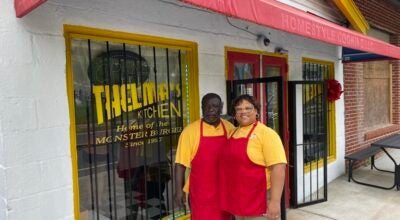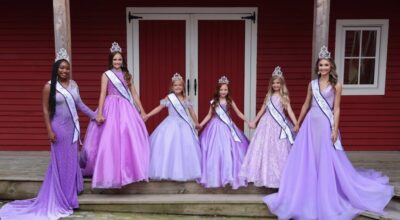Several peach varieties available this summer
Published 6:05 pm Monday, June 28, 2010
One peach isn’t just any peach. To the average buyer, one might be as good as another. But the high volume of different varieties could make someone’s head spin.
Last Saturday’s peach auction saw a wide range of them too, the winner being a basket of PF13s, a popular variety developed in Michigan.
Gala, Southern Pearl, Topaz, Cornette-N, Bounty, Harvester, Sunnyland, Cary Mac, Red Haven, Flavor Crest and Peach Jubilee were all represented at Jack Hayes Field for the auction, which saw 24 baskets Saturday sold for a grand total of $11,775.
But how does a shopper tell the difference between so many different types of peaches? One could bite right in and determine it in the juice. While the taste tells the whole story, farmers suggest you can see it in the color, size and shape.
Mark Knight’s PF13s delivered the M&M Farms representative his third consecutive auction title. While the auction peaches depend more on aesthetic value, Knight knows just as much about what makes a Chilton County peach taste so good.
“We’ve got a lot of varieties around here,” he said. “Naturally the freestones coming in now and really popular at the current timeframe. It’s got a good melting flesh that breaks away from the seeds. They have a better taste. They’re the most popular right now.”
Knight said Loring peaches will soon challenge freestones as the most sought-after fruit this summer, as will Red Havens, a medium-sized fuzzless peach with a creamy yellow flesh, and Elbertas, typically red blushed over a deep golden yellow color. The Loring peach is a large yellow peach with some hints of red blush and a melting yellow flesh. He said you won’t find many orange or red Lorings.
“The Loring’s a great tasting peach,” Knight said.
Knight then listed several other types, including white peaches like Georgia and Carolina Belles.
He’s aware of somewhere between 125-200 varieties overall and about 30-40 kinds in Chilton County.
Some are distinct even in their juice. Knight said the Summer Prince variety has an unmistakable blood red juice.
Some can even be deceiving. He noticed Jerry Harrison’s Cornette-N at the peach auction and said some might think it’s too ripe by the look of it when it is not.
Knight still foresees the Loring peaches as the ones that should sell the most for him.
“It really has to do with the season,” he said. “Flame Prince and Bounty peaches have been good to me. Those are just coming in. Three of four weeks from now, that’s when we’ll see the Flame Prince and Big Red peaches. Those will be the most popular.”
Flame Prince and Big Red are both freestone variety peaches.
Gary Gray, a regional extension office agent who helped with the peach auction, said the Elberta parentage are a popular variety, due to a distinct taste and disease-resistant process.
“Elberta is an old variety that folks have enjoyed for generations,” Gray said. “Fewer Elbertas are grown these days but several newer varieties have Elberta parentage with the good flavor of Elberta with better growing qualities.”
He said the popularity of the freestone variety often stems from their flexibility in cooking situations.
“Freestones are easier to slice for cooking, canning or freezing,” he said. “Most varieties ripening after mid-June are freestone. Our earliest ripening varieties, harvested beginning mid-May, are all cling varieties.”
Gray said varieties are generally harvested over about a two-week period in order for commercial peach producers to plant several to ripen over the course of the summer.
“Our peach season usually ends with the latest varieties being harvested around Labor Day weekend,” Gray said. “Some varieties with renowned flavor include Loring, O’Henry, and one of my favorites, a white nectarine, Karla Rose.”
Growers choose varieties with several purposes in mind, Chilton Research and Extension Center superintendent Jim Pitts said. It starts with consistent yields, which is why the majority of the county’s peaches require 550-900 chill hours. The lower the chill hours, he said, the earlier the bloom.
The early blooming varieties as a whole are too risky but there are some such as Florida Kin, largest peach in it’s ripening season, that some growers will risk to gain the price advantage the years it makes,” Pitts said. “Early varieties have the advantage of providing that ‘first taste of summer’ usually demand a better price and are not that great in size or taste and exhibit split pits.”
Growers also take a risk when they don’t pick any peaches if a late freeze occurs. This forfeits the entire investment to grown the fruit for that year.
Pitts said the second reason for picking a peach variety is size. Quality is often determined by the size.
“The larger, the better,” Pitts said. “The mid-season freestone varieties have the best opportunity to gain the 2.75 to 4-inch diameter.
Pitts said color is the third major factoring in the variety distinctions. And it matters a great deal.
Ask any teenager which color corvette he wants, and nine out of 10 will pick a red one,” Pitts said. “The same is true with peaches. The redder the color they have, the more attractive it is.”
But traditional peach lovers, he said, who know the color and fruit characteristics of certain varieties are not lured by the red color. Popular varieties, such as Loring, do not achieve a red shade particularly well, instead turning more golden yellow. Those Lorings do not have the most ideal shape either, growing oblong with deep sutures and pointed.
Growers typically look for a round or slightly oblong shape with very small suture and no point, Pitts said.
“Unfortunately, some varieties have these qualities, and others don’t,” he said. “There is not a list of varieties that will display the desired qualities all season long. So for a grower to be able to supply peaches all summer long they will have to grow about 30 to 40 varieties.”
Ripening dates can move on certain varieties 5-10 days from previous years. To achieve this, growers pick the best selection for the season and even a few more in the same season to make up differences from ripening variations.
But the details tend to escape Pitts when he holds a peach.
“To sum it up, the best tasting peaches to me is the one I am eating, but as a whole peaches ripening from mid-June to early August are the best,” Pitts said.






